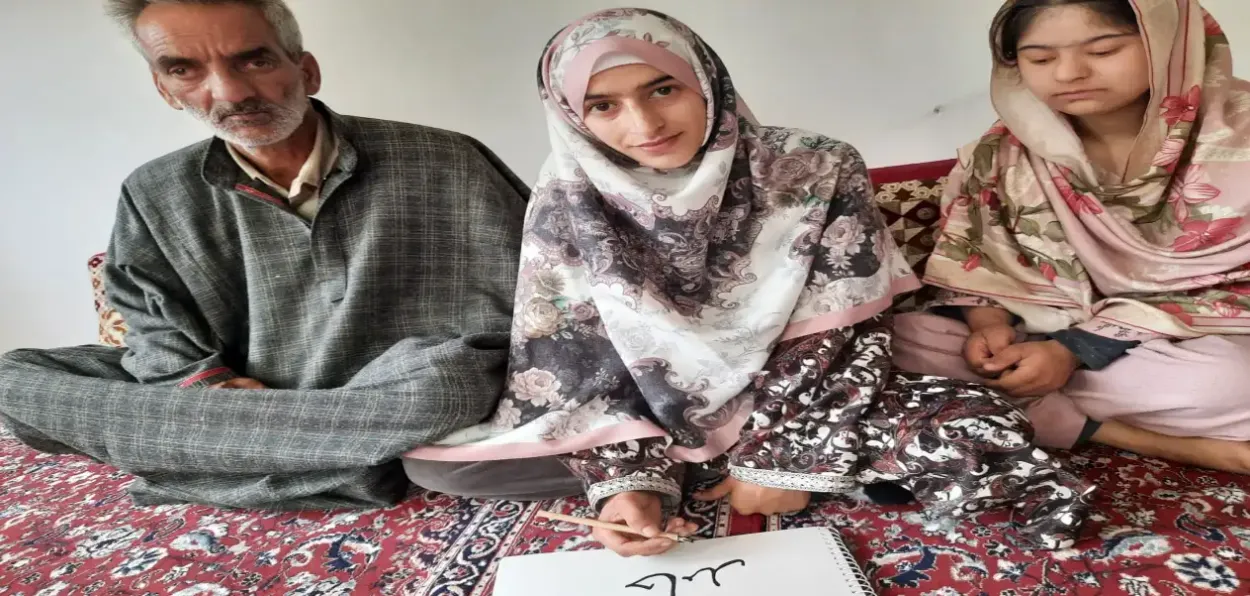
Ehsan Fazili/Srinagar
When Firdousa Bashir was prompted to display her work of calligraphic art on a little shop in Kehribal village of South Kashmir, little did she know that it would lead to accolades from across the country. This display caught the attention of locals, mostly students of her age and the scribes producing small videos for social media.
Firdousa Bashir, who has been working hard to fulfil her dream of becoming a professional calligrapher, was elated on hearing Prime Minister, Narendra Modi mention her name in the latest edition of “Mann Ki Baat” on October 27.
While talking about “extraordinary people” across the country, the Prime Minister spoke of two artists from Jammu and Kashmir - Firdousa Bashir and Gorinath, Sarangi player from Udhampur district of Jammu region, for popularizing local culture.
“Firdousa Bashir Ji from Anantnag, who has expertise in calligraphy, is bringing forth local culture through that. Firdousa ji’s calligraphy has attracted the local people, especially the youth”, the Prime Minister remarked. That was only few weeks after she had displayed her calligraphic skills.
.jpeg) Some of the works of Firdousa Bashir
Some of the works of Firdousa Bashir
However, her lack of resources did not come in her way of continuing with learning the calligraphic sketching on the paper using a kalam (a pen made from a twig) with black ink basis.
“Since my school days, I was interested in writing both English and Urdu. When I started reading the holy Quran I became interested in writing the Arabic…I tried to write like that (Arabic)”, she said.
Since clearing her 10 plus 2 examination from Government Boys Higher Secondary School, Mattan, she has been pursuing Aalima course from Tahreek-e-Soutul Awliya, an Islamic educational institute at Ashajipora, Anantnag. The course is a study of the Islamic sciences encompassing expertise in Arabic grammar, literature, Tafseer-ul-Quran, etc.
.jpeg)
Some of the works of Firdousa Bashir
Along with helping her mother with chores, Firdousa practices calligraphy daily. “I had no phone (mobile) and had to learn it on my own even as it was going frequently wrong”, she told Awaz-the Voice. “I want to get training from experts”.
Her aim is to become a “good calligrapher” as she looks forward to a “great learning and expertise”.
The display of her work caught the attention of locals, mostly students, who sought to get their names written by Firdousa in calligraphic art in different sizes, she said. She framed her works and displayed them on a shop in Kehribal village, close to her native village. The mountain slopes to Kehribal village support walnut trees while the rest of the land is ditted with apple orchards.
Firdousa was surprised when she was informed that PM Modi’s “Mann Ki Baat” at a week-long Calligraphy workshop organized by the J&K Academy of Art, Culture and Languages. The workshop was organized in collaboration with Whispers Ink (NGO) at the Life School, Chrar-e-Sharief. She shared her experiences with 100 budding calligraophers and in the presence of the Principal Secretary, J&K Academy of Art, Culture and Languages, Harvinder Kour.
Firdousa Bashir was awarded an Appreciation certificate by the Deputy Commissioner, Anantnag on the occasion of National Unity Day in appreciation of her contribution to art and culture.
The art of calligraphy was introduced in Kashmir by scholar-saint, Sharief-ud-Din Bulbul in the 14th century. The art holds traditional significance in Kashmir. Verses from the Quran are mostly engraved on the walls of mosques and shrines.
The calligraphic art of writing was appreciated by the Union Home Minister, Amit Shah on his visit to an exhibition of the J&K Academy on the occasion of “Vitasta Mahautsav” in Srinagar on June 23 last year. “Vitasta-The Festival of Kashmir” showcasing the rich culture, arts and crafts of Kashmir” had been organized to take the rich art, culture, literature, craft and cuisine of Kashmir to the whole country.
ALSO READ: Chhath Puja: Cultures around world venerate Sun God
The J&K Academy of Art, Culture and Languages offers diploma course in Calligraphy for nearly 50 years since 1972, and according to sources, has been shelved since 2019, though various programmes are being conducted in this field.
